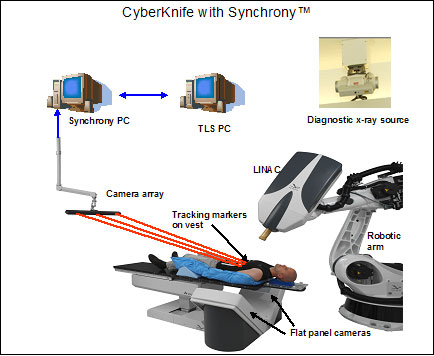Single-Topic News Release
Radiation-Armed Robot Rapidly Destroys Human Lung Tumors
Super-intense radiation delivered by a robotic arm eradicated lung tumors in some human patients just 3-4 months after treatment, medical physicist Cihat Ozhasoglu, Ph.D. of the University of Pittsburgh Medical Center (ozhasogluc@upmc.edu) will report in early August at the 48th Annual Meeting of the American Association of Physicists in Medicine in Orlando. Although it is too early to determine the technique's long-term effectiveness, Ozhasoglu and his colleagues find promise in this new approach to treat lung cancer and other tumors that move during breathing.
At the University of Pittsburgh, Ozhasoglu and approximately 30 colleagues form one of the largest US teams devoted to the CyberKnife, a radiation delivery system that uses an accurate, precise robotic arm to aim highly focused x-ray beams at the site of a tumor. Currently there are 76 active CyberKnife sites worldwide (with 45 in the US), and an additional 62 scheduled to be installed globally.
Recently, the Pittsburgh researchers upgraded their CyberKnife by adding a system called "Synchrony," which accurately targets tumors that move as a result of breathing. Synchrony instructs the robotic arm to move the radiation source (a linear accelerator that produces x-rays) in sync with the tumor motion.
As a result of the unique real-time tumor tracking capabilities of their upgraded CyberKnife, the researchers have established detailed methods for the safe treatment of lung tumors which otherwise couldn’t be treated with a high dose of radiation due to lack of sufficient real-time tracking accuracy in other, more conventional radiation therapy machines.
Treating lung tumors with the enhanced Cyberknife requires only 1-3 sessions lasting 60-90 minutes. In conventional radiotherapy, patients typically get dozens of radiation treatments, each lasting about 15 minutes but requiring 20-30 hospital visits.
In a single treatment, Cyberknife blasts a lung tumor from all sides by delivering typically 100-150 intense, focused x-ray beams, causing the tumor to absorb approximately 10 times more radiation than in a conventional radiotherapy session. Cyberknife can deliver so much more radiation than other techniques because its robotic arm aims the x-rays precisely enough to avoid surrounding healthy tissue.

Main components of the CyberKnife with Synchrony are: (1) Linear Accelerator (LINAC) mounted on robotic arm; (2) Two flat panel cameras positioned perpendicular to diagnostic x-ray sources mounted to ceiling; (3) Synchrony-tracking vest with LED markers attached; (4) Camera array which holds three CCD cameras; (5) Synchrony and Target Locating Computers. (Image used with permission from Accuray Incorporated.)
To track the moving tumor, the CyberKnife takes real-time x-ray pictures of the patient while using external markers attached to the patient’s chest or abdomen to follow tumors in real time with a few millimeters of accuracy. The researchers also applied Synchrony to treating tumors in the thorax and abdomen, which can move as much as 4 cm during respiration.
Meeting Paper: WE-D-VaIA-4, "Synchrony -- Real-Time Respiratory Compensation system for the CyberKnife," Wednesday, August 2, 2006, 2:20 PM, Room Valencia A. Click Here for Technical Abstract
Presented at: 48th Annual Meeting of the American Association of Physicists in Medicine, July 30-August 3, 2006, Orange County Convention Center, Orlando, FL. Click Here for Meeting Homepage
ABOUT AAPM
AAPM (www.aapm.org) is a scientific, educational, and professional organization of more than 6,000 medical physicists. Headquarters are located at the American Center for Physics in College Park, MD. Publications include a scientific journal ("Medical Physics"), technical reports, and symposium proceedings.
###
For more information, please contact Ben Stein of the American Institute of Physics, bstein@aip.org, 301-209-3091, Jeff Limmer, AAPM Media Relations Subcommittee Chair, jeffl@aspirus.org, or Martha Heil, American Institute of Physics, 301-209-3088, mheil@aip.org